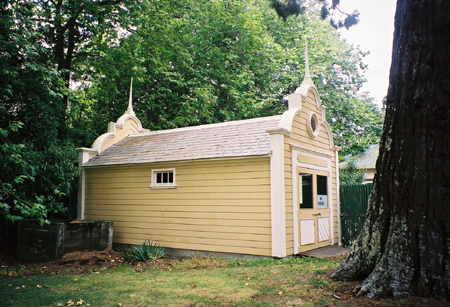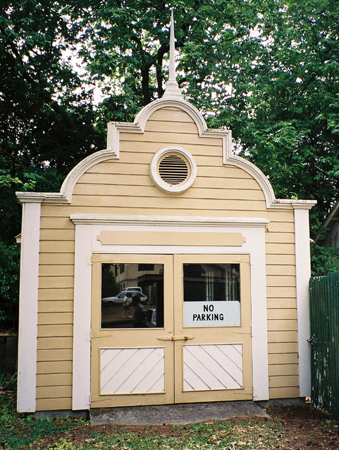The Fire Engine House was built in 1866 to house the fire engine intended to protect the Nelson Provincial Council Buildings from fire. It is now the only remaining reminder of the demolished government buildings. The Nelson Provincial Council Buildings were erected in 1859. The buildings were Nelson's most important administrative buildings and, being constructed of timber, were at considerable risk from fire. Nelson's first volunteer fire brigade was formed in 1858 and the Liverpool and London Fire Insurance Company purchased a fire engine for the brigade. However, by 1863 the enthusiasm of the volunteer fire fighters had evaporated and the fire brigade was described as being 'exceedingly weak'. As a result, the Provincial Council ordered their own fire engine from London to protect the Council Buildings. The engine was a Shand and Mason model that was capable of discharging 609 litres [134 gallons] of water per minute arrived in late 1863. It was initially housed in a dilapidated old shed close to the Council Buildings. Two years later, after a pointed comment was made in the Examiner in June 1865, £100 was allocated for the erection of a more suitable building. The Fire Engine House was designed by architect Robert McDonald and built by the Assistant Engineer for the Nelson Province, Henry Handyside. A simple, single storey building with large double doors at either end, Fire Engine House cost £122 10s 4d to construct. The rectangular structure measures 3.7 metres by 5.5 metres (12 foot by18 foot). It is made of the same materials architect Maxwell Bury used to construct the government buildings. It has a concrete base, weatherboard walls, a timber ceiling and a roof of slate. The architecture of Fire Engine House imitated the architecture of the government buildings. This is particularly noticeable in its distinctive gables, which were replicas of the gables that adorned the government buildings. The Fire Engine House was completed and ready for use early in 1866. For a short period it served as the main engine house for Nelson. By 1866 the Provincial Government had a fire engine and had provided accommodation for it. However, it is unknown what arrangements the Provincial Government made for the operation of the fire engine, either for its use within Albion Square, or for further a field. Indeed it is unknown if it was operational at any point. In June 1865 the Examiner, in the same article that commented on the poor accommodation afforded to the fire engine, pointed out that while the fire engine had been put in good working order (in 1864, after trials of it proved unsatisfactory) there remained no one who could operate it. Certainly efforts to develop a volunteer fire brigade that would service the wider area continued, indicating at the very least gaps in any service the Provincial Government may have provided. An attempt in July 1865 to establish a brigade 'with the necessary money and powers' by way of an act of the Provincial Government came on the back of failed efforts to organise a volunteer force. The bill itself did not proceed due to the sudden death of its draftsman. This set of circumstances remained until a devastating fire destroyed 18 Nelson buildings in August 1866. It underlined the need for an organised fire brigade and almost immediately afterwards the Nelson Volunteer Fire Brigade was formed. In 1867 a new, public fire station was erected in Harley Street. It was large enough to hold the fire engine and had the advantage of having a meeting place upstairs for members of the fire brigade. The Fire Engine House in Albion Square was used for meetings of the Nelson Volunteer Fire Brigade in the interim and for a time after the completion of the Harley Street building. The building is best remembered for its use as a morgue shortly after its completion. In 1866 four men were robbed and killed by the notorious Kelly gang on the road that led from the Wakamarina goldfields to Nelson. The bodies of the men were discovered in June. It is uncertain why they were taken to Fire Engine House as the city had a morgue but one drawing suggests that they may have been displayed there before the horrified Nelson public. Three of the four murderers were hung shortly afterwards and the 'Maungatapu murders' have become part of the folklore of Nelson. While there is no evidence to suggest that the building was used as a morgue after the murders, the memory of its use for the murder victims persisted and it became known as 'the old morgue'. In 1876 the provincial government system ended and both the Provincial Council Buildings and Fire Engine House were handed over to the Crown. Fire Engine House was used primarily as garage and storage space. In 1969, one hundred years after they were erected and despite public protest, the Provincial Council Buildings were demolished. Fire Engine House, built to protect it, was passed over and in 1974 renovation of the building commenced with the intention of converting it into a museum. Despite this the building remains empty, a solitary reminder of Nelson's years of self-government. The Former Provincial Council Buildings' Fire Engine House is architecturally significant as the only remaining physical link with Nelson's Provincial Council Buildings. The Provincial Council Buildings were an important part of Nelson's history and the use of similar materials and the same architectural detail in Fire Engine House provides an authentic, visual reminder of the demolished buildings. The Fire Engine House is historically significant as an example of an early, purpose-built fire house, although it is unknown if it was operational at any time. The building is an important marker in the development of Nelson's fire fighting services and its connection to the Maungatapu murders adds to its cultural interest.


Location
List Entry Information
Overview
Detailed List Entry
Status
Listed
List Entry Status
Historic Place Category 1
Access
Private/No Public Access
List Number
257
Date Entered
9th September 1984
Date of Effect
9th September 1984
City/District Council
Nelson City
Region
Nelson Region
Legal description
Secs 201 203 Pt Secs 179 180 181 200 202 -Historic Reserve
Location Description
Located in Albion Square Historic Area which is bounded on the north and south side by Hardy Street and Bridge Street in Nelson.
Stay up to date with Heritage this month
